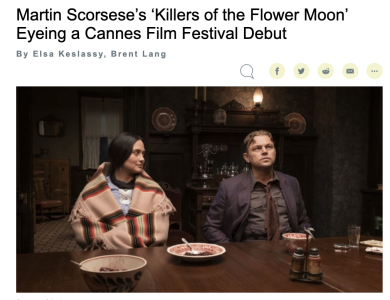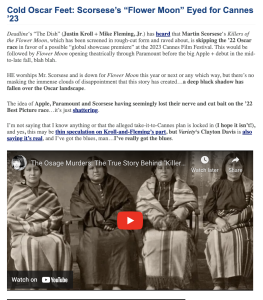…holding their Best Picture Oscars and taking a stab at earnest and eloquent, which will almost certainly come out impromptu and awkward. Maybe they’ll mention Swiss Army Man and slip in a reference to flatulence?
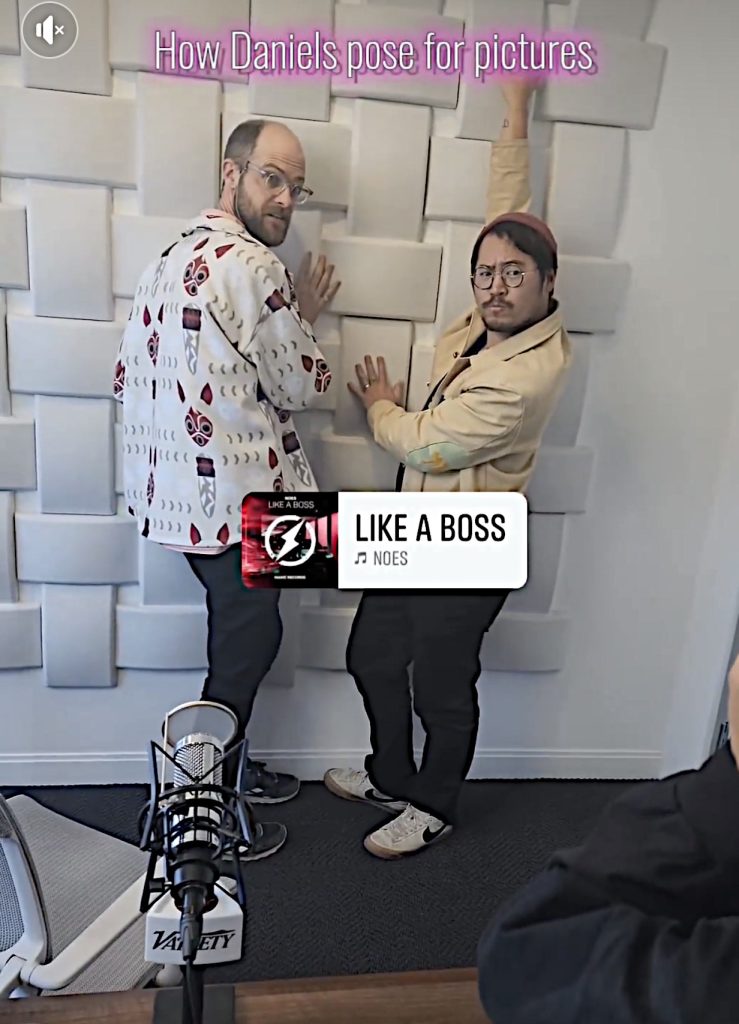
…holding their Best Picture Oscars and taking a stab at earnest and eloquent, which will almost certainly come out impromptu and awkward. Maybe they’ll mention Swiss Army Man and slip in a reference to flatulence?

Five and 1/3 years ago I passed along a brief personal tale about sexual molestation. It happened in New Orleans when I was 19 and blind drunk. Suffice to say that I woke up in a French Quarter hotel room with a heavy-set 50 year-old dude in New Orleans. That’s as far as I’m going to go, detail-wise, but I’m 99% sure nothing happened. And if it did, I don’t want to think about it.
Yesterday I was having lunch with an ex-girlfriend from 40-odd years ago and her husband, plus a friend of theirs. The three of them were roaring along with conversation at a fairly high speed, and I was trying to jump into the chatter like a 1930s hobo hopping on a freight train, but they were going too fast. Every so often I’d hear a word or a phrase and would try to jump on…”hey, hold on, guys, slow down…I’ve got an observational nugget here! Wait, wait!…okay.”
I began to lose track of time but there I continued to be, running alongside the freight train and starting to feel winded and then a tad despairing.
So eventually I figured, “What the hell…the next observational nugget will have to be a conversation stopper…I won’t even look to precisely add to the topic of the moment…I’ll just drop something into the conversation like a hand grenade.” Hence the drunken New Orleans thing.
All to say I might not have inserted this sordid tale if I could’ve figured some way to jump on the train, but I couldn’t. I wasn’t fast or fleet-of-mind enough.
There’s an anarchist that lives inside me. He takes orders from the rationalist and the humanist, but he has a voice and sometimes gives me great ideas for column topics and is very much the free-thinker, but there are some stories that should probably not be shared during a nice lunch.
Directed and written by Jon “Spiderman” Watts (helmer of Spider-Man: Homecoming, Spider-Man: Far From Home and Spider-Man: No Way Home), Wolves is a star-driven (Brad Pitt, George Clooney) urban thriller of some kind. Maybe a little goofy…maybe a stab at clever.
Logline: “Two professional fixers find themselves hired for the same job.” I would be interested anyway because of what it apparently is, but also because I’m a huge fan of the second half (but not the first half!) of No Way Home.
Wolves had been shooting in the New York area for three or four weeks. Clooney and Pitt are also producing. Has anyone read the script? Is it boilerplate or a level or two above? Will Apple release it later this year or what?
Last posted on 12.21.19: “Sometime in the late winter or early spring of ’83 I flew from New York to Los Angeles for a job interview, and during the visit I went out to Universal studios to poke around. I wound up climbing a chain-link fence and walking onto a sound stage where, lo and behold, Scarface was being shot. The huge set contained a portion of Tony Montana‘s Miami mansion — the upstairs office, the red-carpeted foyer and staircase, a portion of the white-painted exterior with royal palm trees outside.
Hanging on a wall near the base of the staircase was a fairly large (at least six or seven feet tall) oil portrait of Al Pacino‘s Tony and Michelle Pfeiffer‘s Elvira Hancock. I’m no authority on oil portraits, but it looked like an absolutely first-rate effort. Someone had taken the time to make it look like a serious artist (one who knew from color and shadow and subtle gradations) had worked on it. In the film the painting is seen for maybe 1.5 seconds, if that.
I’ve long wondered what happened to this grand portrait. Did Brian DePalma or [the late] producer Marty Bregman make off with it? Online you can buy cheap knockoff versions with bullet holes, but the real thing was quite impressive.
Obviously Peter Weir‘s direction, Earl W. Wallace and William Kelley‘s screenplay and John Seale‘s cinematography, coupled with Lucas Haas and Harrison Ford‘s performances. But the most active ingredient is Maurice Jarre‘s score. That’s what really siezes and brings you in.
Jarre, who passed in 2009 at age 84, was unquestionably pantheon-level. I know that Doctor Zhivago is generally regarded as sappy and that we’re not allowed to praise it too strongly, but Jarre’s music for David lean’s 1965 film melts me down every time I hear. Not to mention his scores for Lawrence of Arabia, The Train (’64), Grand Prix (’66), The Man Who Would Be King (1975), The Year of Living Dangerously (’82 w/ Vangelis), Witness (’85), The Mosquito Coast (’86), Fatal Attraction (’87), Gorillas in the Mist (’88), Dead Poets Society (’89), and Ghost (’90)
A day or two ago I read about about Ashley Morgan Smithling recanting her allegation of sexual abuse against Marilyn Manson, which appeared nine months ago in People magazine (5.5.21). But I was afraid to re-post and discuss for fear of the #MeToo brigade using it to say I’m defending Marilyn Manson. You know how they are. It seemed safer to bypass it. Yes, I am capable of cowardice.
Friendo: “Yeah, I think it’s the Armie Hammer thing…kind of a domino effect. No one wants to be exposed like that so they get ahead of the story. It’s the right thing to do to tell the truth. I never bought her story, and I can’t stand MM.”
Boilerpate: Marilyn Manson accuser Ashley Morgan Smithline has recanted her sexual abuse allegations against the musician. As in “oops, never mind.”
In a 2.19.23 Los Angeles Superior Court filing, Smithline has stated she was “manipulated” by actress and ex-Manson fiancée Evan Rachel Wood and others to accuse Manson of sexual and physical abuse. “I succumbed to pressure from Evan Rachel Wood and her associates to make accusations of rape and assault against [Manson] that were not true,” the statement says.
Smithline stated that she had a “brief, consensual sexual relationship with Brian Warner,” aka Marilyn Manson, in November 2010.
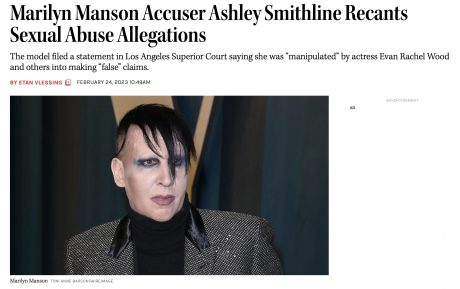
Scott Adams, the Dilbert guy, asked for the grief he’s in. He said some blunt stuff that might be true in some respects (i.e., deep down there’s probably not a great amount of love for white people among a good portion of black people, and who could blame them?) but it was crazy unwise to say this stuff on social media.
The trigger, Adams said, was this 2.22.23 Rasmussen poll.
Friendo: “Yeah, agreed. Like the severe anti-trans stuff, all it does is feed the beast. It vindicates the crazies. Like suddenly they found a real witch in Salem.
“The only part I agree with is that no matter what you do the woke crazies call you a racist, because they believe every white person IS racist. You’re either flat-out racist or unconsciously racist, but either way you’re pretty bad.”
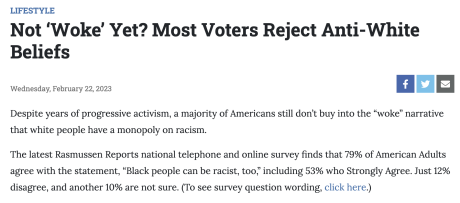

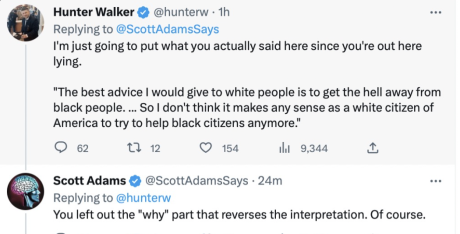
For me at least.
From Brett Easton Ellis’s recollection of seeing The Shining for the very first time on 5.23.80, at the Westwood Village:
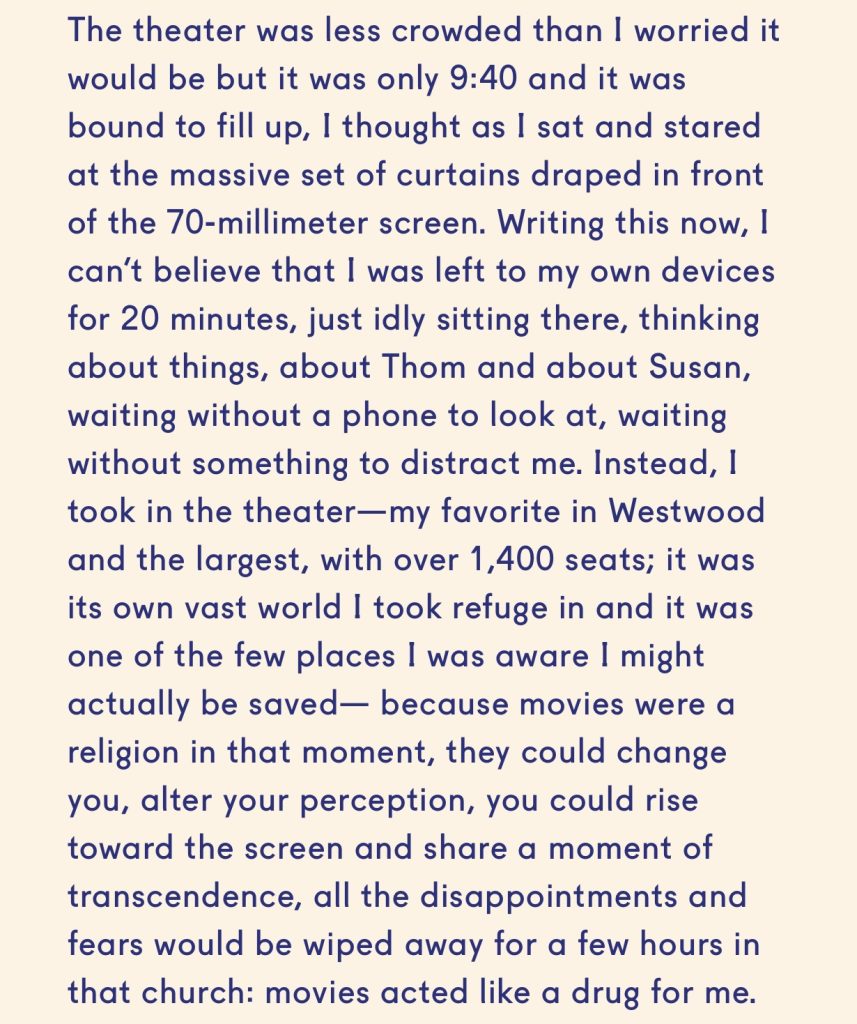
As I began to glumly settle into an awareness of the kind of film Cocaine Bear is — a film that’s weirdly cottonball and barren but at the same time not a piece of shit and which is reasonably well-framed, cut, written and directed…as I took stock of what it was up to, I didn’t know what to make of it. Really…I was lost.
I can report that I laughed twice, which should count for something.
I honestly don’t know what to say except that CB is some kind of dopey–ass hybrid deadpan comic gorefest, and yet one that’s chortle-worthy at times and even touches bottom once or twice. “This is a wank, a waste of time,” I was muttering, “but it’s not that awful.”
I found myself lamenting, in fact, that director Elizabeth Banks and screenwriter Jimmy Warden had decided to go for dumb laughs — if they’d only committed to making some kind of dry, half-realistic ensemble docu-dramedy, CB might have amounted to something (though I can’t quite imagine what that would be exactly).
I’ll tell you this much — the late Ray Liotta plays it totally straight as a furrowed-brow drug dealer, and I felt really badly that he wasn’t allowed to play a nogoodnik of greater consequence, or at least that he wasn’t given better lines.
Alden Ehrenreich (whose hair is going gray already!) plays Liotta’s half-heartedly criminal son, and I swear to God he’s more compelling in this role than he was in Solo or Rules Don’t Apply.
The steadily low-key O’Shea Jackson Jr. is wasted, and that bummed me out. Ditto Keri Russell as a good mom searching the forest for her 13-year-old daughter (Brooklyn Prince, who of course looks nothing like Russell)…she also plays it straight like Ehrenreich and Liotta.
I just wish Banks hadn’t tried to goof her way through it. I wish she’d made this film in a Steven Soderbergh-type way. That’s all I’m saying.
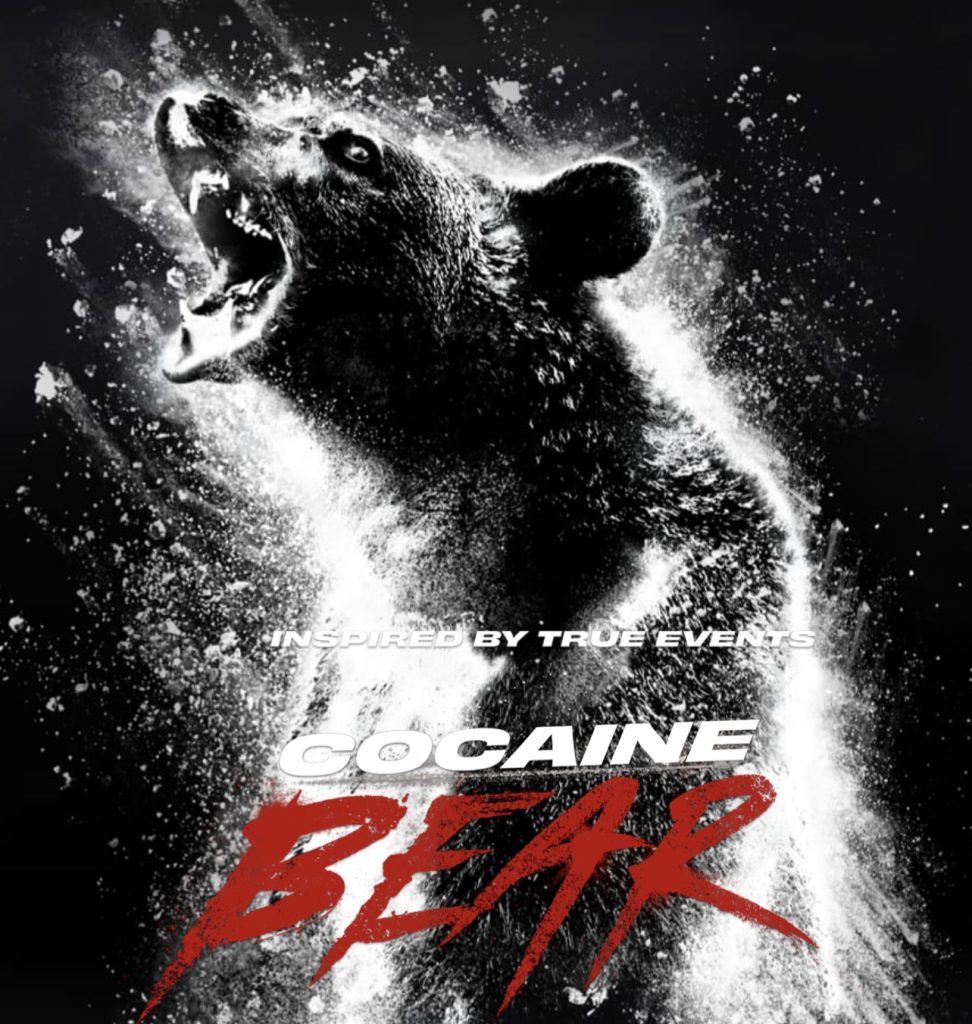
Hollywood Elsewhere will be submitting to Elizabeth Banks‘ Cocaine Bear sometime around 5:25 pm eastern. Call it 5:30. I’ll post some kind of half-assed, lean-and-mean, “don’t fuck with me” reaction by 8 pm…okay, no later than 9. Meanwhile the early birds are saying it’s not awful, “reasonably silly”, “gonzo goofy,” etc.
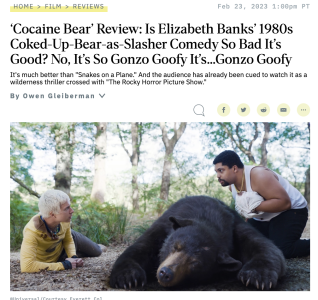
HE readers know that Martin Scorsese‘s Killers of the Flower Moon will almost certainly have its big debut at the 2023 Cannes Film Festival. So what follows is mostly water under the bridge.
I know that I popped in for a little taste on 7.26 (i.e., seven months ago) after Mike Fleming and Justin Kroll reported that Flower Moon would be skipping a late ’22 release in favor of “a possible ‘global showcase premiere’ at the 2023 Cannes Film Festival.”
On Jan. 12 World of Reel‘s Jordan Ruimy reported that “two sources” had told him Flower Moon would play Cannes.
I was told privately on February 1st that this would indeed happen.
The last columnist to report same was Showbiz 411‘s Roger Friedman, on Monday, 2.20.
And now (Thursday, 2.23) Variety‘s Elsa Keslassy and Justin Kroll have posted a Cannes caboose story, timidly reporting that Killer Moon is “eyeing” a Cannes debut. Their story qualifies three times that the Cannes booking isn’t 100% firmed, but it is, I’ve been told. Plane fares and hotels are booked — done deal. Probably in an out-of-competition slot.
